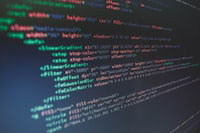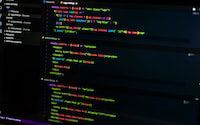 Backend Development
Backend Development Python Tutorial
Python Tutorial The Definitive Guide to Data Analysis with Python: A Deep Dive
The Definitive Guide to Data Analysis with Python: A Deep Dive
python has become the mainstream language in the field of data analysis, providing a set of powerful tools and libraries, Can be used for data processing, visualization and modeling. This guide is designed to provide data analysts with a comprehensive overview covering key aspects of Python data analysis, helping them get the most out of this powerful language.
Data processing and manipulation
- NumPy and Pandas: Core libraries for processing and manipulating multidimensional arrays and tabular data.
- Data cleaning and preprocessing: Handle missing values, duplicates and outliers to prepare the data for analysis.
- Merge and Join: Combine data sets from different sources to create a comprehensive data set.
data visualization
- Matplotlib and Seaborn: Create various types of charts, such as line charts, bar charts, and scatter plots.
- Data interaction: Use libraries such as Bokeh and Plotly to create interactive visualizations that allow users to explore data.
- Customize visualizations: Enhance the presentation of your visualizations with custom colors, fonts, and layout options.
Statistical Modeling
- Scikit-learn: Provides a wide range of machine learningalgorithms for supervised learning and unsupervised learning.
- Linear regression: Used to predict continuous target variables.
- Logistic regression: is used to predict binary categorical variables.
- Decision tree: Used to create complex decision boundaries.
Machine Learning
- Supervised learning: Train a model using labeled data to predict target values on new data.
- Unsupervised learning: Discover hidden patterns and structures in unlabeled data.
- Model evaluation: Evaluate model performance using cross-validation, ROC curves, and other metrics.
Advanced Theme
- Natural Language Processing (NLP): Analyze text data and extract insights.
- Time Series Analysis: Predict trends and patterns in time series data.
- Big Data Analysis: Processing and analyzing Big Data sets that extend traditional methods.
Best Practices
- Use version control: Manage code changes and allow collaboration.
- Unit testing: Verify the correctness and robustness of the code.
- Documented code: Clearly describe functions and usage.
- Continuous Learning: Keep up with evolving trends and technologies in the field of Python data analysis.
case study
- Customer churn prediction: Use logistic regression model to predict customer churn risk.
- Stock Price Forecast: Use time series analysis model to predict stock price fluctuations.
- Social Media Sentiment Analysis: Use NLP techniques to analyze the sentiment in social media posts.
in conclusion
Python provides a comprehensive set of tools and libraries that enable data analysts to efficiently process, visualize, and model data. By mastering these techniques and following best practices, data analysts can deeply understand data, extract valuable insights from it, and make informed decisions.
The above is the detailed content of The Definitive Guide to Data Analysis with Python: A Deep Dive. For more information, please follow other related articles on the PHP Chinese website!
 Python ORM 性能基准测试:比较不同 ORM 框架Mar 18, 2024 am 09:10 AM
Python ORM 性能基准测试:比较不同 ORM 框架Mar 18, 2024 am 09:10 AM对象关系映射(ORM)框架在python开发中扮演着至关重要的角色,它们通过在对象和关系数据库之间建立桥梁,简化了数据访问和管理。为了评估不同ORM框架的性能,本文将针对以下流行框架进行基准测试:sqlAlchemyPeeweeDjangoORMPonyORMTortoiseORM测试方法基准测试使用了一个包含100万条记录的SQLite数据库。测试对数据库执行了以下操作:插入:向表中插入10,000条新记录读取:读取表中的所有记录更新:更新表中所有记录的单个字段删除:删除表中的所有记录每个操作
 Python ORM 在大数据项目中的应用Mar 18, 2024 am 09:19 AM
Python ORM 在大数据项目中的应用Mar 18, 2024 am 09:19 AM对象关系映射(ORM)是一种编程技术,允许开发人员使用对象编程语言来操作数据库,而无需直接编写sql查询。python中的ORM工具(例如SQLAlchemy、Peewee和DjangoORM)简化了大数据项目的数据库交互。优点代码简洁性:ORM消除了编写冗长的SQL查询的需要,这提高了代码简洁性和可读性。数据抽象:ORM提供了一个抽象层,将应用程序代码与数据库实现细节隔离开来,提高了灵活性。性能优化:ORM通常会使用缓存和批量操作来优化数据库查询,从而提高性能。可移植性:ORM允许开发人员在不
 Yii框架简介:了解Yii的核心概念Jun 21, 2023 am 09:39 AM
Yii框架简介:了解Yii的核心概念Jun 21, 2023 am 09:39 AMYii框架是一个高性能、高扩展性、高可维护性的PHP开发框架,在开发Web应用程序时具有很高的效率和可靠性。Yii框架的主要优点在于其独特的特性和开发方法,同时还集成了许多实用的工具和功能。Yii框架的核心概念MVC模式Yii采用了MVC(Model-View-Controller)模式,是一种将应用程序分为三个独立部分的模式,即业务逻辑处理模型、用户界面呈
 深入了解常用的7种Java设计模式Dec 23, 2023 pm 01:01 PM
深入了解常用的7种Java设计模式Dec 23, 2023 pm 01:01 PM了解Java设计模式:常用的7种设计模式简介,需要具体代码示例Java设计模式是一种解决软件设计问题的通用解决方案,它提供了一套被广泛接受的设计思想与行为准则。设计模式帮助我们更好地组织和规划代码结构,使得代码具有更好的可维护性、可读性和可扩展性。在本文中,我们将介绍Java中常用的7种设计模式,并提供相应的代码示例。单例模式(SingletonPatte
 使用 Python ORM 实现高效的数据持久性Mar 18, 2024 am 09:25 AM
使用 Python ORM 实现高效的数据持久性Mar 18, 2024 am 09:25 AM对象关系映射(ORM)是一种技术,它允许在面向对象编程语言和关系数据库之间建立桥梁。使用pythonORM可以显著简化数据持久性操作,从而提高应用程序的开发效率和可维护性。优势使用PythonORM具有以下优势:减少样板代码:ORM自动生成sql查询,从而避免编写大量的样板代码。简化数据库交互:ORM提供了一个统一的接口,用于与数据库交互,简化了数据操作。提高安全性:ORM使用参数化查询,可以防止SQL注入等安全漏洞。促进数据一致性:ORM确保对象与数据库之间的同步,维护数据一致性。选择ORM有
 用 Python Tkinter 为你的项目增添 GUI 魅力Mar 24, 2024 am 09:46 AM
用 Python Tkinter 为你的项目增添 GUI 魅力Mar 24, 2024 am 09:46 AMTkinter是python中用于创建图形用户界面(GUI)的一个强大库。它以其简单性、跨平台兼容性和与Python生态系统的无缝集成而闻名。通过使用Tkinter,您可以为您的项目添加用户友好的界面,从而提高用户体验并简化与应用程序的交互。创建TkinterGUI应用程序要使用Tkinter创建GUI应用程序,请执行以下步骤:导入Tkinter库:importtkinterastk创建Tkinter主窗口:root=tk.Tk()配置主窗口:设置窗口标题、大小、位置等添加GUI元素:使用Tki
 Python vs. Jython:谁是跨平台开发之王?Mar 22, 2024 pm 12:21 PM
Python vs. Jython:谁是跨平台开发之王?Mar 22, 2024 pm 12:21 PMpython和Jython都是流行的编程语言,但它们针对不同的用例进行了优化,并在跨平台开发方面具有独特的优势和劣势。Python优势:广泛的库和社区支持易于学习和使用,适合初学者可移植性强,可跨多个平台运行支持多种编程范式,包括面向对象、函数式和命令式编程劣势:性能较低,不适合处理密集型计算任务对内存消耗较高在某些平台上可能需要其他工具和配置Jython优势:完全与Python兼容,可以使用Python的所有库和工具运行在Java虚拟机(JVM)上,提供与Java生态系统的无缝集成性能优于Py
 Python Pandas 数据处理利器,新手入门必读!Mar 20, 2024 pm 06:21 PM
Python Pandas 数据处理利器,新手入门必读!Mar 20, 2024 pm 06:21 PMpandas是python中强大的数据处理库,专门用于处理结构化数据(如表格)。它提供了丰富的功能,使数据探索、清洗、转换和建模变得简单。对于数据分析和科学领域的初学者来说,掌握Pandas至关重要。数据结构Pandas使用两种主要数据结构:Series:一维数组,类似于NumPy数组,但包含标签(索引)。DataFrame:二维表,包含具有标签的列和小数。数据导入和导出导入数据:使用read_csv()、read_excel()等函数从CSV、Excel和其他文件导入数据。导出数据:使用to_


Hot AI Tools

Undresser.AI Undress
AI-powered app for creating realistic nude photos

AI Clothes Remover
Online AI tool for removing clothes from photos.

Undress AI Tool
Undress images for free

Clothoff.io
AI clothes remover

AI Hentai Generator
Generate AI Hentai for free.

Hot Article

Hot Tools

SublimeText3 Linux new version
SublimeText3 Linux latest version

WebStorm Mac version
Useful JavaScript development tools

Dreamweaver CS6
Visual web development tools

SAP NetWeaver Server Adapter for Eclipse
Integrate Eclipse with SAP NetWeaver application server.

SublimeText3 Chinese version
Chinese version, very easy to use





